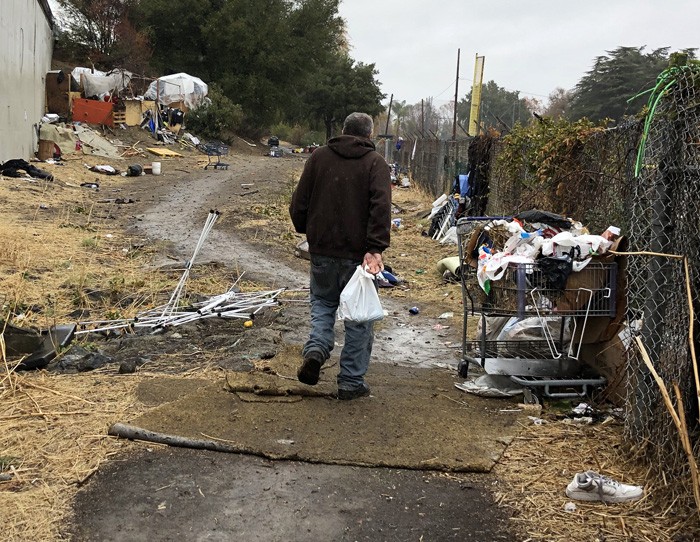Where do you go when there’s no place to go? Concord struggles to find answers.

CONCORD, CA—It was moving day for Shawn B. His current living arrangement had come to an end. It was raining and he was packing up. But Shawn had a bigger problem than rain. He had nowhere to go.
Shawn is one of an estimated 200 living on Concord streets; under overpasses, along the flood channel, in medians, behind Costco—anywhere there is space enough for a tent or sleeping bag.
These are Concord’s unhoused. Some live in minimal shelters crafted from found plywood and discarded cardboard. Others including whole families, live in their cars or RVs, moving from place to place hoping to find a place to charge their phones so the kids can do schoolwork. And some like Shawn B find a place for a tent, a make-shift shower, a butane hotplate, and a few tools. He keeps an orderly campsite and tries to stay as far away from other campers as he can hoping he will be overlooked when the sweep comes.
“We have hundreds living out there and we aren’t bothering them,” Concord council member Edi Birsan said. “We don’t move them unless health, safety or crime is involved.”
Seeking shelter
In Shawn’s camp, occupants had dug shelters into the side of the hill along Highway 242 undermining the freeway. Others tapped into private power lines which creates a fire hazard.
“Over 70 percent of the wildfires in Contra Costa County are caused by the homeless,” said Birsan.
Where do they go when they have no place to go?
“This is the billion dollar question,” Council member Carlyn Obringer said.
Concord has a homeless shelter, but it is being held for patient overflow in the event the hospitals run out of beds. Seniors and families can get shelter through hotel vouchers, Shelter, Inc., and a few other services. But many, like Shawn, don’t qualify for any of the programs.
Shawn had a job until March when the gym where he worked closed because of the virus. He has a little money, but not enough to rent an apartment and can’t find a room. “No one wants a stranger in their house during COVID,” he said.
Refusing help
Others on the street have been offered help but refuse it. Mental health issues, addiction, disabilities are major reasons.
“I have nightmares over it,” Birsan said. “I really want the ability to forceably take someone who is mentally ill and get them off the street on the basis they are a danger to themselves.”
Police chief Mark Bustillos will address the mental health issues at the Jan. 26 city council meeting. The city has allocated funds for a full time, CORE outreach team. Obringer is working with the Winter Nights temporary shelter program, and individuals and charities do what they can to meet immediate needs.
There is no one fix, and the need is far greater than available solutions.
“If there was an easy solution, we would have found it,” Birsan said.
Next month: We take a closer look at the resources available.
